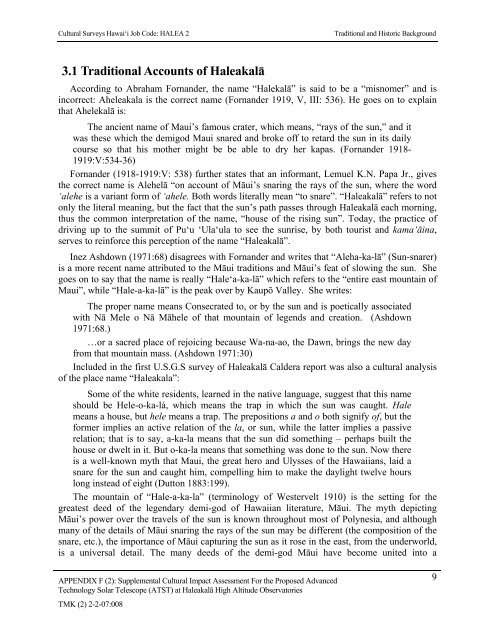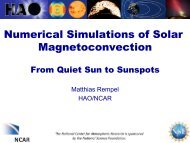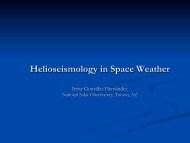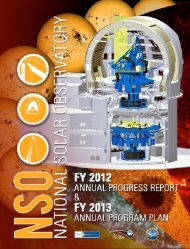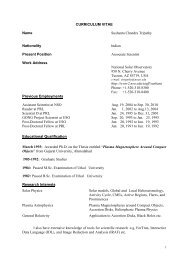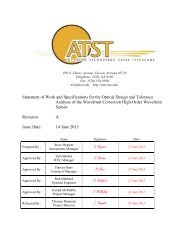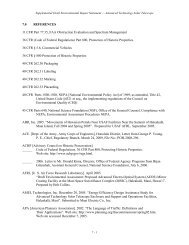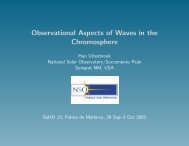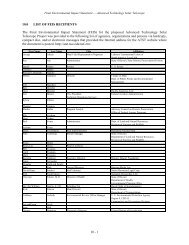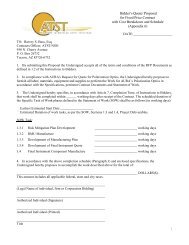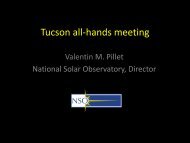F2 - ATST
F2 - ATST
F2 - ATST
Create successful ePaper yourself
Turn your PDF publications into a flip-book with our unique Google optimized e-Paper software.
Cultural Surveys Hawai‘i Job Code: HALEA 2Traditional and Historic Background3.1 Traditional Accounts of HaleakalāAccording to Abraham Fornander, the name “Halekalā” is said to be a “misnomer” and isincorrect: Aheleakala is the correct name (Fornander 1919, V, III: 536). He goes on to explainthat Ahelekalā is:The ancient name of Maui’s famous crater, which means, “rays of the sun,” and itwas these which the demigod Maui snared and broke off to retard the sun in its dailycourse so that his mother might be be able to dry her kapas. (Fornander 1918-1919:V:534-36)Fornander (1918-1919:V: 538) further states that an informant, Lemuel K.N. Papa Jr., givesthe correct name is Alehelā “on account of Māui’s snaring the rays of the sun, where the word‘alehe is a variant form of ‘ahele. Both words literally mean “to snare”. “Haleakalā” refers to notonly the literal meaning, but the fact that the sun’s path passes through Haleakalā each morning,thus the common interpretation of the name, “house of the rising sun”. Today, the practice ofdriving up to the summit of Pu‘u ‘Ula‘ula to see the sunrise, by both tourist and kama‘āina,serves to reinforce this perception of the name “Haleakalā”.Inez Ashdown (1971:68) disagrees with Fornander and writes that “Aleha-ka-lā” (Sun-snarer)is a more recent name attributed to the Māui traditions and Māui’s feat of slowing the sun. Shegoes on to say that the name is really “Hale‘a-ka-lā” which refers to the “entire east mountain ofMaui”, while “Hale-a-ka-lā” is the peak over by Kaupō Valley. She writes:The proper name means Consecrated to, or by the sun and is poetically associatedwith Nā Mele o Nā Māhele of that mountain of legends and creation. (Ashdown1971:68.)…or a sacred place of rejoicing because Wa-na-ao, the Dawn, brings the new dayfrom that mountain mass. (Ashdown 1971:30)Included in the first U.S.G.S survey of Haleakalā Caldera report was also a cultural analysisof the place name “Haleakala”:Some of the white residents, learned in the native language, suggest that this nameshould be Hele-o-ka-lá, which means the trap in which the sun was caught. Halemeans a house, but hele means a trap. The prepositions a and o both signify of, but theformer implies an active relation of the la, or sun, while the latter implies a passiverelation; that is to say, a-ka-la means that the sun did something – perhaps built thehouse or dwelt in it. But o-ka-la means that something was done to the sun. Now thereis a well-known myth that Maui, the great hero and Ulysses of the Hawaiians, laid asnare for the sun and caught him, compelling him to make the daylight twelve hourslong instead of eight (Dutton 1883:199).The mountain of “Hale-a-ka-la” (terminology of Westervelt 1910) is the setting for thegreatest deed of the legendary demi-god of Hawaiian literature, Māui. The myth depictingMāui’s power over the travels of the sun is known throughout most of Polynesia, and althoughmany of the details of Māui snaring the rays of the sun may be different (the composition of thesnare, etc.), the importance of Māui capturing the sun as it rose in the east, from the underworld,is a universal detail. The many deeds of the demi-god Māui have become united into aAPPENDIX F (2): Supplemental Cultural Impact Assessment For the Proposed Advanced 9Technology Solar Telescope (<strong>ATST</strong>) at Haleakalā High Altitude ObservatoriesTMK (2) 2-2-07:008


